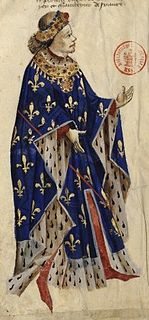"Prince Robert" is one of the 305 ballads collected by Francis James Child during the late nineteenth century.
Prince Robert may also refer to:

Year 839 (DCCCXXXIX) was a common year starting on Wednesday of the Julian calendar.
Year 1383 (MCCCLXXXIII) was a common year starting on Thursday of the Julian calendar.
Charles, Prince of Wales is the current heir-apparent to the British throne.
William I, called the Bad or the Wicked, was the second king of Sicily, ruling from his father's death in 1154 to his own in 1166. He was the fourth son of Roger II and Elvira of Castile.
Henry may refer to:

Louis I, called the Lame was a French prince du sang, Count of Clermont-en-Beauvaisis and La Marche and the first Duke of Bourbon, as well as briefly the titular King of Thessalonica from 1320 to 1321.
Prince Henry may refer to:

The Duchy of Benevento was the southernmost Lombard duchy in the Italian Peninsula that was centred on Benevento, a city in Southern Italy. Lombard dukes ruled Benevento from 571 to 1077, when it was conquered by the Normans for four years before it was given to the Pope. Being cut off from the rest of the Lombard possessions by the papal Duchy of Rome, Benevento was practically independent from the start. Only during the reigns of Grimoald and the kings from Liutprand on was the duchy closely tied to the Kingdom of the Lombards. After the fall of the kingdom in 774, the duchy became the sole Lombard territory to continue to exist as a rump state, maintaining its de facto independence for nearly 300 years, although it was divided after 849.

Roger Borsa was the Norman Duke of Apulia and Calabria and effective ruler of southern Italy from 1085 until his death.

The Principality of Taranto was a state in southern Italy created in 1088 for Bohemond I, eldest son of Robert Guiscard, as part of the peace between him and his younger brother Roger Borsa after a dispute over the succession to the Duchy of Apulia.
Pandulf II the Old was the prince of Benevento from 981 and prince of Capua from 1008 or 1009 to his death, the son of Landulf III who was co-prince between 959 and 968. Pandulf was first associated as co-prince in 977.

The Hauteville was a Norman family originally of seigneurial rank from the Cotentin. The Hautevilles rose to prominence through their part in the Norman conquest of southern Italy. By 1130, one of their members, Roger II, was made the first King of Sicily. His male-line descendants ruled Sicily until 1194. Some Italian Hautevilles took part in the First Crusade and the founding of the Principality of Antioch (1098).
Robert (1153/4–1159/60) was the second son of King William I of Sicily and his queen, Margaret of Navarre. He was about four or five years old when he was appointed Prince of Capua in 1157 or 1158. Prior to his accession, since 1144, his father had been Prince of Capua. Robert's Latin title, princeps Capuanorum, means literally "Prince of Capuans". He was the third Robert of Capua, after Robert I and Robert II. The latter, who had been deposed in 1135, returned in 1155–56 in an effort to reclaim his principality. He managed to control some territory, but was ultimately unsuccessful. The young Robert's rule in Capua can be traced in documents between September 1158 and May 1159, but he had died by February–March 1160, when his father was once again ruling Capua directly. Eventually, Robert's younger brother Henry was appointed Prince of Capua in May 1166.

The Lombard Principality of Salerno was a medieval Southern Italian state, formed in 851 out of the Principality of Benevento after a decade-long civil war. It was centred on the port city of Salerno. Although it owed allegiance at its foundation to the Carolingian emperor, it was de facto independent throughout its history and alternated its allegiance between the Carolingians and their successors in the West and the Byzantine emperors in the east.

The Capetian House of Anjou or House of Anjou-Sicily, was a royal house and cadet branch of the direct French House of Capet, part of the Capetian dynasty. It is one of three separate royal houses referred to as Angevin, meaning "from Anjou" in France. Founded by Charles I of Anjou, the youngest son of Louis VIII of France, the Capetian king first ruled the Kingdom of Sicily during the 13th century. Later the War of the Sicilian Vespers forced him out of the island of Sicily, leaving him with the southern half of the Italian Peninsula — the Kingdom of Naples. The house and its various branches would go on to influence much of the history of Southern and Central Europe during the Middle Ages, until becoming defunct in 1435.

The Norman conquest of southern Italy lasted from 999 to 1139, involving many battles and independent conquerors.
William of Orange usually refers to either:
Richard I was king of England from 1189 to 1199.
Francis of Baux was the first Duke of Andria, Count of Montescaglioso and Squillace, and Lord of Berre, Mison, and Tiano. He was the son of Bertrand III of Baux, Count of Andria and Montescaglioso and his second wife, Marguerite d'Aulnay. Francis's father was a Senator of Rome, Captain General of Tuscany, and Justiciar of Naples. The half-royal Baux family was one of the greatest families of the kingdom after the Duke's marriage to Marguerite of Taranto in 1348.